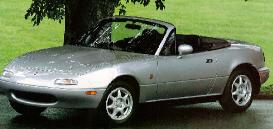

One of the more difficult classes of car to buy used, especially old and used, is a sports car. Not a luxury sports car, like a Mercedes or Jaguar, but an affordable one like an older British Leyland model or, in my case, a Mazda Miata. Though not as dangerous as muscle cars, which are usually well-flogged by the time they are resold, they do tend to be in precarious condition. This is due to the nature of the beast. British sports cars are renown for lack of quality, questionable materials, and proclivity to rust out from under you. Italian sports cars, such as Fiats and Alfa Romeos, are notorious for, shall we say, cutting trips short. Cars from both of these countries stopped trickling into the US years ago and the American motoring public turned to sports coupes and variations on the theme. But for those of us that remember the glorious times out of dry-dock with 2-place open touring machines, the love affair is merely embellished in the heart and mind's eye. British sports cars, MGs, Austin Healeys, Triumphs, et al, endeared themselves to us, not for their unreliability, lack of power, or parts to the mile, but for their handling, throaty roar, and the splendor of rowing a shifter through the gears as the wind enveloped you and sun and blue skies were just a glance upward. For sure there have been myriad convertibles available, but the low-slung, tiny and brash sports car holds a special place for all of us who remember.
The Mazda Miata is all that was the classic British sports car except for two major features: 1) It works, and 2) It doesn't break. It has the quality of an economy sedan with the character, look, and sound of the machines of yore. When I decided to add a 2-place convertible to my household, only two cars came immediately to mind-the Miata and a Corvette. A quick scan of the local auto trade papers suggests that, in some instances, these cars can be purchased for the same relative sum. The working capital I had was in the neighborhood of $8,000. My hope was to find a car for roughly $6,000 and use the remainder for repairs, updates, appearance, etc. With that in mind, I picked up a local auto trader publication and scanned the pages to see what Miatas were selling for used. I also kept an eye toward Corvettes, just in case. I found that the most affordable car was the original 1990 issue of the Miata in the $8,000 to $8,500 range with something over 80,000 miles on the clock. This was clearly more than I wanted to spend, but within reason. I then went to the Internet and searched on "Miata." This provided me with a huge list of sites to visit that would give me valuable information about the car-what it should sell for, things to look for, and generally what to expect. This information is invaluable. For example, by researching on the Web, I found that there was a known problem with Miatas during the first year and a half of production. This involved a crankshaft that was basically too short and a nose key that could be reinstalled backwards. When the timing belt was replaced, there was a possibility that the key could cause friction and displacement of the crankshaft, causing it to break. Wary of this, I spoke to a Mazda service manager to which I had some acquaintance. He indicated that he'd seen maybe 3 crank problems in 7 years. I then spoke to another service manager in person, and he indicated that he'd never seen the problem or heard of it, and that his staff would never do anything so negligent. This made me feel more secure (but after buying the car, I took it to this dealer with the article from www.miata.net and restated my concern). I printed out the articles I found and made a checklist of the important things to evaluate. Armed with a new and greatly expanded knowledge, I was ready to do battle with any seller.
I test-drove a red 1990 Miata parked on a Lexus dealer lot. The asking price was $9,900, but I thought that some flexibility was in order, even though it had less than 40,000 miles showing. It was in good mechanical condition, but had been superficially neglected. They wouldn't budge on the price but offered to detail it and replace the rotted rear window. I declined the offer. They called several days later ready to bargain, but I had already settled on another car. I found it in the front yard of a moderately-traveled road displayed with a small but dignified sale sign. The asking price was $6,500. It was a silver 1990 with black top and interior and an honest 104,000 miles. It was clean inside and out and mechanically sound. I used my list to check every potential trouble spot and got the owner to agree to have it taken to a garage of my choice to check the spots I could not. For this, I left him a $500 deposit. The car proved to be sound and we negotiated the price down to $5,800, based on the arguments I had for book value and the potential for crank problems in a car that old. (It also had never had the timing belt replaced.) It passed state inspection and needs very little, but I replaced the cam and cam sensor seals, which were leaking internally; the timing belt; the top; and shod it with new tires. Total cost: $1,200. It still needs little things, like front brake pads, a new air filter, and probably new plugs, but it drives fine and is a great fun car. Best of all, it is a car that can truly be considered a classic in its era.
When purchasing a classic auto, I advise the following:
--Larry Lefkowitz